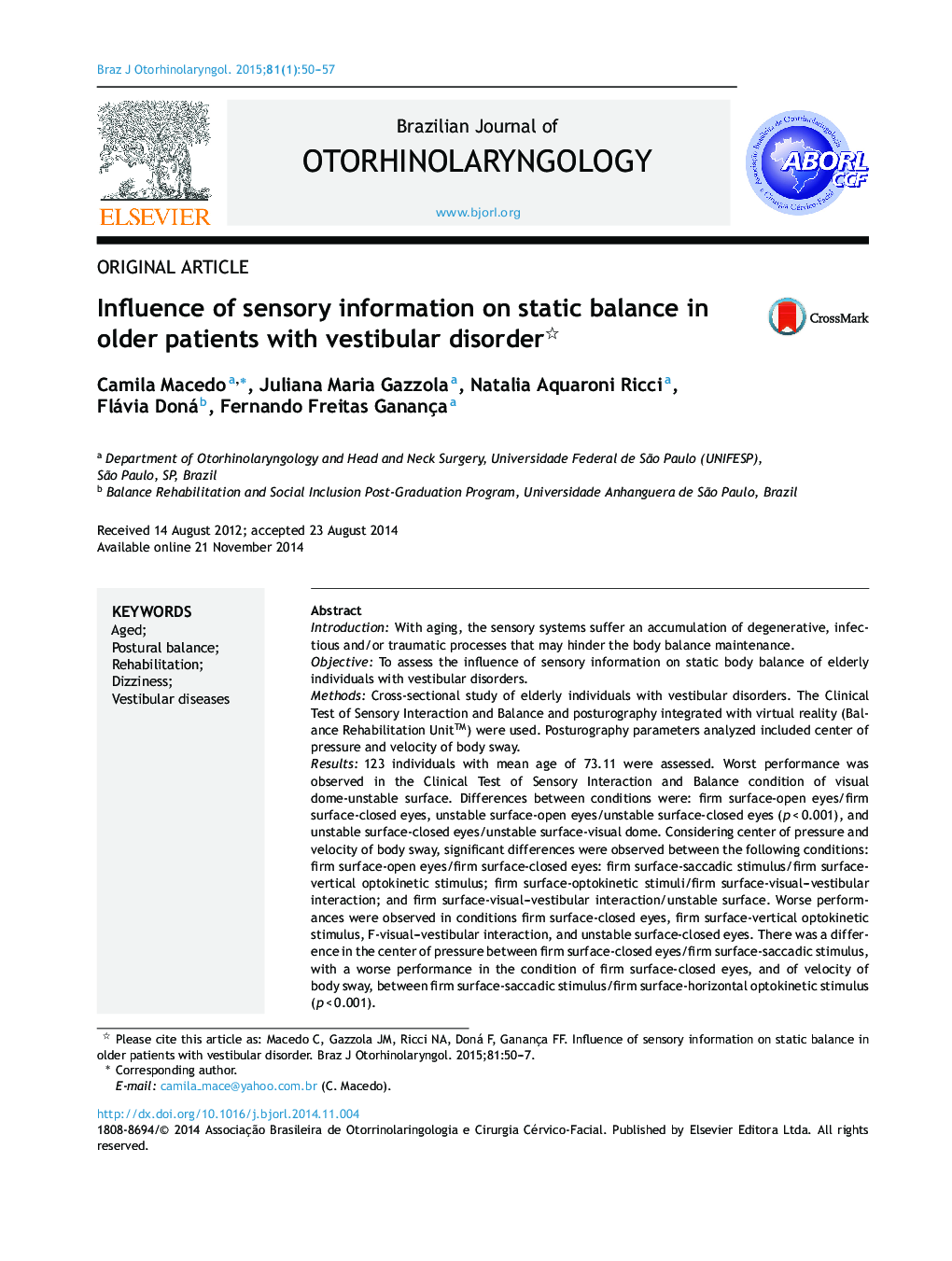| Article ID | Journal | Published Year | Pages | File Type |
|---|---|---|---|---|
| 4106283 | Brazilian Journal of Otorhinolaryngology | 2015 | 8 Pages |
IntroductionWith aging, the sensory systems suffer an accumulation of degenerative, infectious and/or traumatic processes that may hinder the body balance maintenance.ObjectiveTo assess the influence of sensory information on static body balance of elderly individuals with vestibular disorders.MethodsCross-sectional study of elderly individuals with vestibular disorders. The Clinical Test of Sensory Interaction and Balance and posturography integrated with virtual reality (Balance Rehabilitation Unit™) were used. Posturography parameters analyzed included center of pressure and velocity of body sway.Results123 individuals with mean age of 73.11 were assessed. Worst performance was observed in the Clinical Test of Sensory Interaction and Balance condition of visual dome-unstable surface. Differences between conditions were: firm surface-open eyes/firm surface-closed eyes, unstable surface-open eyes/unstable surface-closed eyes (p < 0.001), and unstable surface-closed eyes/unstable surface-visual dome. Considering center of pressure and velocity of body sway, significant differences were observed between the following conditions: firm surface-open eyes/firm surface-closed eyes: firm surface-saccadic stimulus/firm surface-vertical optokinetic stimulus; firm surface-optokinetic stimuli/firm surface-visual–vestibular interaction; and firm surface-visual–vestibular interaction/unstable surface. Worse performances were observed in conditions firm surface-closed eyes, firm surface-vertical optokinetic stimulus, F-visual–vestibular interaction, and unstable surface-closed eyes. There was a difference in the center of pressure between firm surface-closed eyes/firm surface-saccadic stimulus, with a worse performance in the condition of firm surface-closed eyes, and of velocity of body sway, between firm surface-saccadic stimulus/firm surface-horizontal optokinetic stimulus (p < 0.001).ConclusionStatic body balance in elderly individuals with vestibular disorders is worse when the sensory conditions are more challenging, i.e. stable and unstable surfaces, visual stimuli, such as optokinetic and visual–vestibular interaction, and with the eyes closed.
ResumoIntroduçãoCom o envelhecimento, o sistema sensorial sofre um acúmulo de processos degenerativos, infecciosos e/ou traumáticas que podem dificultar a manutenção do equilíbrio corporal.ObjetivoAvaliar a influência das informações sensoriais no equilíbrio corporal estático de idosos vestibulopatas.MétodoEstudo transversal, cuja amostra foi constituída por idosos vestibulopatas. Empregaramse o Clinical Test of Sensory Interaction and Balance (CTSIB) e a posturografia integrada à realidade virtual (Balance Rehabilitation Unit.). Os parâmetros avaliados à posturografia foram: área do centro de pressão (COP) e velocidade de oscilação (VOC).ResultadosForam avaliados 123 idosos, com média etária de 73,11 anos. O pior desempenho ocorreu na condição cúpula visual-superfície instável (SI) do CTSIB. As diferenças entre as condições foram: superfície firme (SF)-olhos abertos (OA)/SF-olhos fechados (OF) e SI-OA/SI-OF (p < 0,001); SI-OF/SI-cúpula visual. Observou-se diferença da área do COP e da VOC entre as condições: SF-OA/SF-OF; SF-estímulo sacádico/SF-estímulo optocinético vertical; SF-estímulos optocinéticos/SF-interação visuo-vestibular (IVV); SF-IVV/SI, com pior desempenho nas condições SF-OF, SF-estímulo optocinético vertical, SF-IVV e SI-OF. Observou-se diferença do COP entre as condições SF-OF/SF-estímulo sacádico, com pior desempenho na condição SF-OF, e da VOC entre as condições SF-estímulo sacádico e SF-estímulo optocinético horizontal (p < 0,001).ConclusãoO equilíbrio corporal estático de idosos vestibulopatas é pior à medida que as condições sensoriais são mais desafiadoras, ou seja, em SI e SE, estímulos visuais como os optocinéticos e interação visuovestibular e OF.
